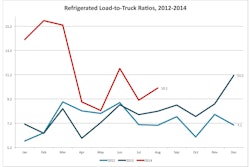
While a natural disaster like the late August San Francisco earthquake drives home the need for emergency preparedness in the food supply chain, the more subtle nuances of everyday changes in consumer lifestyles point to less dramatic but equally alarming aspects of a changing retail landscape. Consumers, armed with mobile Internet connectivity, are purchasing food when and where they want like never before. The result is a more fragmented retail marketplace that makes logistics more important for food marketers.
The recent U.S. Grocery Shopper 2014 Trends report from the Food Marketing Institute (FMI) examines shifts consumer shopping habits. The 142-page report flushes out changes in where consumers buy food. The data was based on the results of an online survey of 2,116 shoppers in the U.S. between the ages of 18 and 74.
The changes detailed in the report impact every player in the retail food chain. Every player, from the manufacturer to the wholesaler to the retailer, needs to know where the consumer is spending more of their time and what products and services they are looking for. They need their transportation and logistics partners to be up to speed on the challenges they face. One thing this report made clear is that these challenges are growing.
Who shops the way they used to?
As I scanned the FMI report, I was struck by how many of the changes I could relate to personally as a shopper. I had not realized how much my own shopping habits have changed in recent years. Several years ago, my wife and I made one weekly trip to the same supermarket for groceries.
Today, we go to four retailers a week – two “dedicated” (traditional) supermarkets, one general merchandise discounter that sells food, and a membership warehouse club. In addition, every other week, we visit an independent grocer that specializes in fresh produce and often has outstanding limited-time offers. We also review coupons two or three times a week from CVS and daily via email.
My own experience speaks to one of the FMI report’s overriding themes – the jump in the number of consumers who no longer have a primary store for food shopping. Clearly, I am not the only shopper who no longer relies on one store to satisfy all his or her needs.
The report notes that 9 percent of consumers in 2014 said they have no primary store for grocery shopping. That might not sound like a big number, but it triples the previous year’s number. The trend first emerged in 2011 when 2 percent of consumers indicated no primary store for food purchases.
The lack of a primary destination for food challenges food marketers to manage more different types of retail destinations. This represents both a marketing and logistics challenge.
Longer-term trends, meanwhile, continue to confront the food industry.
Away-from-home shopping grows
Away-from-home food spending has been growing at the expense of at-home food spending since 1953. In 2006, the Great Recession interrupted this trend for the first time, but the interruption didn’t last long. Away-from-home food spending rebounded in 2008, and in 2014, food spent away from home nearly matched at-home food spending.
If present trends continue, foodservice could overtake retail in consumer food spending. Major growth opportunity remains for food processors in the foodservice market compared to the retail channel.
Food logistics professionals continue to play a big role in enabling manufacturers to maximize the growing foodservice opportunity.
E-commerce represents another growth opportunity, one that relies on astute logistics support as much as any retail channel. Thus far, it doesn’t look like e-commerce plays a big role in food sales; only 8 percent of consumers have ordered any groceries online, the FMI report notes.
But as a shopping tool, the Internet is empowering shoppers to determine what products they want and where they want to get them. And mobile commerce has revolutionized how people shop.
Food marketers need to stay connected to consumers on an ongoing basis if they want to win their business. Mobile Internet is making it happen. The more shopping options they give consumers, the more they will sell. To maximize options, food companies need to ship orders on fast notice from as many different delivery points as possible.
While only 8 percent of consumers have ordered groceries online, 27 percent have used the Internet to view prices, availability and coupons in planning a shopping trip, the FMI report notes.
Keep in mind that mobile connectivity has only recently become a common lifestyle, and the millennial generation has not yet reached maturity as a household buying audience. Big changes are in store.
Millennials bring different habits
The FMI report notes the millennial generation is first generation to engage in “meal based” shopping in a big way. This refers to planning a grocery list around meals as opposed to the traditional mindset of keeping a kitchen pantry stocked. These millennial consumers are as likely to build their shopping list around recipes (43 percent) or a plan of specific meals (36 percent) as around sales specials promoted by the store (37 percent).
Yes, I was surprised by how many of the changes in the FMI report I could relate to as a shopper. But when I consider the fact that I am a baby boomer, I can only imagine how different the retail food landscape will look when the millennial generation reaches their prime spending years.
Elliot Maras is managing editor of Food Logistics.
GRAPHIC:
(BAR CHART)
Shoppers Indicating No Primary Food Shopping Store
2011 2%
2013 2%
2013 3%
2014 9%
Source: Food Marketing Institute U.S. Grocery Shopper Trends, 2011-2014



















